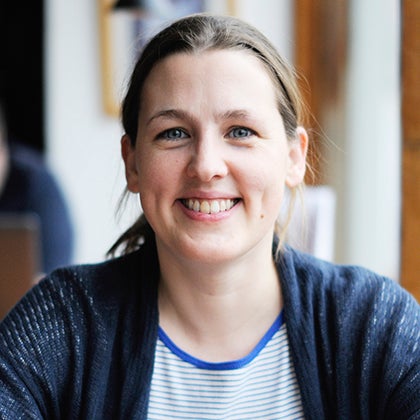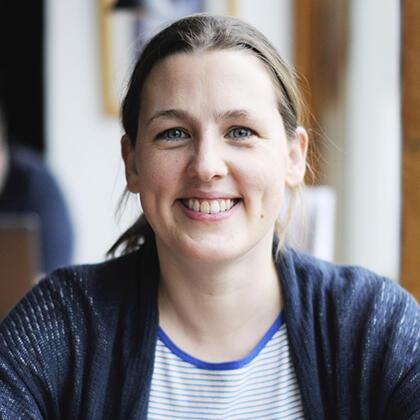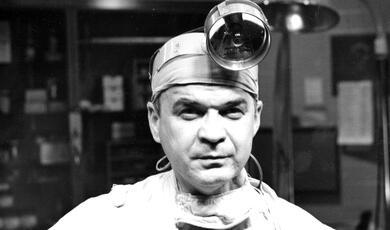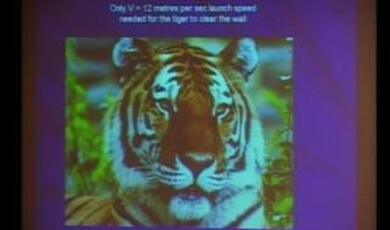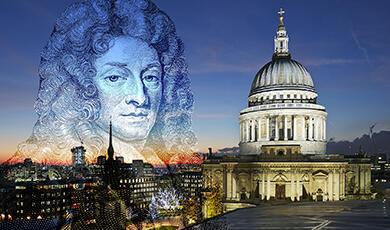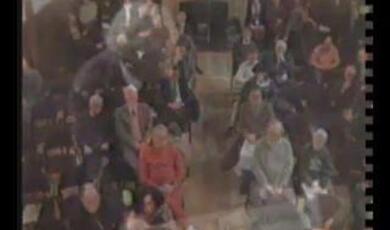Alan Turing: Pioneer of Mathematical Biology
Share
- Details
- Text
- Audio
- Downloads
- Extra Reading
Alan Turing is well-known for his work on the Enigma code in World War II, and his theoretical work underpinning computer science. But he is less well-known for his pioneering work on one of the great challenges of biology – how do complex living organisms develop from tiny collections of cells?
This lecture will discuss Turing’s ground-breaking work in this area, showing how patterns like a leopard’s spots or a zebra’s stripes can occur in nature.
Download Text
Alan Turing: Pioneer of Mathematical Biology
Professor Sarah Hart
6th June 2023
Alan Turing is well-known for his work on the Enigma code in World War II, and his theoretical work underpinning computer science. But he is less well-known for his pioneering work on one of the great challenges of biology – how do complex living organisms develop from tiny collections of cells? And in particular, how do the shapes, forms and patterns in animals and plants emerge from seemingly amorphous beginnings? This is the problem of “morphogenesis”: the emergence of form. In today’s lecture we’ll look at Turing’s ground-breaking 1952 paper: The Chemical Basis of Morphogenesis, ideas from which can help us understand how patterns like a leopard’s spots or a zebra’s stripes can occur in nature.
Who was Alan Turing?
At the start of his description of a mathematical model for morphogenesis, Alan Turing begins by saying “This model will be a simplification and an idealization, and consequently a falsification. It is to be hoped that the features retained for discussion are those of greatest importance in the present state of knowledge.”
My brief biographical sketch will also be a simplification and an idealization, and consequently a falsification. We all know something of Turing. He was born on 23 June 1912, so (at the time of writing) it’s only a few weeks till his eleventy-first birthday. There’s a lovely picture drawn by his mother Sara Turing, of a hockey match in which Alan is supposed to be taking part, but he’s become distracted by looking at the daisies. Maybe a sign of his future mathematical interest in how plants and animals grow? His school years were not happy – he didn’t fit in, he didn’t know how to play the game. Even academically he was criticized – his handwriting was messy, he didn’t focus in class. It did however become clear that he was an extremely able mathematician, and he went to Cambridge to read mathematics in 1931. Already by 1935 he’d been elected a fellow of King’s College Cambridge for a dissertation on probability theory. In 1936 he published On Computable Numbers, with an application to the Entscheidungsproblem. In this paper, he designed a theoretical computer, which we now call a Turing machine, which had a single tape with 0s and 1s on it, and the computer could, based on the number on the tape and the instruction at that stage of the program, either change the number, do nothing, move one step to the left or one step to the right, and go to a different instruction. The amazing thing was that Turing showed that essentially if any computer could do a thing, then this primitive machine could do it too. He is also known for his much later work on what’s now called AI, especially the “Turing Test”, which he originally called the Imitation Game in a 1950 paper. A user interacts via a terminal with two other users, one is a machine and one a human; the user must determine which is which. The machine passes the test if the user mistakenly thinks it is the human.
The work for which he is most famous now is his work at Bletchley Park during the Second World War in cracking the German Enigma encryption machines. These machines had “scrambler” dials along with a plugboard that swapped ten pairs of letters, giving 158,962,555,218,000,000,000 possible settings. Brute force search would be impossible – even a machine that could check a million settings every second would take over five million years to try every possibility. Worse, the settings were changed every day so that you only had 24 hours to crack each version. Alan Turing managed to find a mathematical way to cancel out the effect of the plugboard. This reduced the number of combinations that needed checking to 1,054,560. Too high to check by hand, but with several Bombe computers running simultaneously, it could eventually be done each day within a few hours. It’s estimated that this breakthrough shortened the war by two years.
What does one do when one has contributed incredibly important mathematical work in two completely different areas, one of which for reasons of national security almost nobody knows about. Naturally, one contributes incredibly important work in a third area. By the end of the 1940s, Turing was a Reader at the University of Manchester, and had some time to think about other interests which had necessarily lain dormant during the War years. In the Autumn of 1951, he submitted a paper on morphogenesis, or how plant and animal forms develop, to the Biological Sciences section of the Philosophical Transactions of the Royal Society, and it appeared in 1952. It’s this work we are going to focus on today.
This paper was Turing’s only published output on mathematical biology. Why did he not do more work in this area? The tragic answer is that in the same year The Chemical Basis of Morphogenesis was published, he was tried and convicted of “gross indecency” because he had had a relationship with another man; as a condition of parole he was forced to endure 12 months of “organo-therapy”: crude hormone “treatment”, and on June 7th 1954 he died at home – the verdict at the time was suicide, and sadly it probably was, but we will never know for sure. It was a life tragically cut short. We know he was doing more research in mathematical biology at the time of his death. In his unpublished papers there’s even a draft manuscript called Outline of the development of the daisy – so he was still thinking about them, all these years later. In this lecture I’m going to try to give you the gist of what his paper on morphogenesis did and why it was so important. We’ll start by looking at some of the other ways that mathematical ideas have historically been linked with the natural world.
Watching the Daisies
Symmetry is prevalent in nature. One reason for this could be that symmetry is an efficiency-saving design solution. If a solution is optimal in one direction, then why not just use it in all directions? The only time symmetry doesn’t make sense is if there are constraints that force it to break. Humans, along with other big animals, have bilateral (left-right) mirror symmetry. We have a top and a bottom, because of gravity. We have a back and a front, because we walk and see. But there’s no reason why our left and right sides should need to be different, and so they are more or less the same, at least externally. Animals which are simpler and less constrained can have more symmetry. Gravity is irrelevant to the tiny sea creatures called radiolara which float in the deep ocean waters. Of course, we couldn’t see these until microscopes were good enough. Some of the first images of single-celled organisms like these were drawn by Ernst Haeckel (1834 - 1919). He took part in the HMS Challenger expedition of 1875 and discovered and drew thousands of microscopic organisms with high degrees of symmetry, and published books such as Morphological Symmetries in the Animal Kingdom. Haeckel was a German naturalist and artist. As well as classifying and discovering many new species, he also coined many new words and phrases, including ecology, phylum, stem cell, and possibly even "First World War" – he seems to have been, in 1914, the first person to use that phrase. Haeckel’s drawings of radiolara, which are protozoa (single celled organisms) around 0.1mm in diameter, show startlingly symmetrical geometrical shapes, including what look very like the Platonic solids, the most symmetrical of all polyhedra.
There’s symmetry and pattern in the plant world as well – flowers tend to have radial symmetry, but more than that, the study of phyllotaxis – the arrangement of the leaves on a stem, throws up a lot of mathematics. Turing was certainly interested in the spirals in pine cones and of course we already saw how much he liked daisies. There are good reasons why the Fibonacci numbers seem to occur so often in the spiral structures of plants and the petal numbers of flowers – essentially it’s because they are linked to the famous golden ratio. I went into this a bit in my Gresham lecture on Harmony and Proportion [link at end of transcript] so I won’t say any more here.
In 1917 the Scottish polymath D’Arcy Wentworth Thompson (1860-1948) published a hugely influential book: On Growth and Form. It was a study of how the shapes taken by living organisms relate to mathematical and physical laws. Among a wealth of fascinating observations, I’ll just mention one. It’s that the same basic “recipe” for form can result in a huge variety of final shapes by applying simple mathematical spatial transformations like stretching, shearing, or transforming a rectilinear grid into a grid of radial lines and concentric circles. Thompson gives several sketches of these kinds of transformations showing how they link different fish species to the same, or very similar, underlying blueprints.
There are a couple of other places where mathematical models can mimic what happens in nature. The first of these I mentioned in my lecture on Christopher Wren – he came up with an equation that can model a three-dimensional form of a logarithmic spiral (so called because the relationship between the angle moved through and the radial distance from the centre is a logarithmic one: the angle is proportional to the logarithm of the distance). This, he suggested, could give rise to the shape of shells. Meanwhile, and much later, fractals, which are produced by an iterative process where at each stage component lines are replaced by copies of the initial simple design, were shown to be an excellent way to produce designs that look very like ferns and other plants. The full power of these techniques could not be seen until computers became fast and powerful enough to carry out multiple iterations of the calculations required. As we’ll see, the same issue affected Turing’s work.
The mathematical observations we’ve talked about so far are great at showing what nature might be doing, and even why. But they do not address how nature might be doing it. That’s where Turing comes in.
The Chemical Basis of Morphogenesis
Here is the basic issue that Turing was trying to address – and it’s something that was a huge open question in biology at the time. If we think about how animals grow, the starting point is a single cell – the egg. It’s essentially a sphere – not a perfect mathematical sphere, of course, there would always be tiny imperfections, but these imperfections are small and random – different eggs are imperfect differently. So how does this homogeneous, symmetrical structure develop asymmetry as it grows? How can an apparently uniform surface like an animal’s skin in embryo suddenly, apparently spontaneously, develop pigmentation like spots or stripes? What Turing suggests is one way that this may happen. He shows that phenomena like this could be caused by a system of (as yet unknown) chemical substances, which he calls morphogens to convey, as he says, the idea of “form-producer”, that diffuse through the tissue but also react with each other. If they are in equilibrium (the same amounts being created and destroyed), then nothing changes, but if that equilibrium is unstable, then even very small random imperfections, as would, indeed must, naturally occur, can destroy the equilibrium and give rise to the development of inhomogeneous patterns. It’s these reaction-diffusion models that are what I’m going to talk you through. (In fact, we now know that at least for the case of a fertilized egg, it’s not quite as symmetrical as we thought, proteins present from the mother’s body diffuse from one side of the egg but not the other. So this particular mystery has a different solution. But plenty of others do not. And Turing’s paper was the first to show that simple physical and chemical laws could create such an effect – no special miracle of life is required.)
I’m going to give you the same introductory example Alan Turing used in his paper, but a bit more talkatively! He’s not claiming this precise example exists in nature, but it illustrates the way that something almost homogeneous can lose that symmetry. Imagine we have two adjacent cells, and that they both contain certain concentrations of morphogens 𝑥 and 𝑦. We’ll look at the effect of diffusion and reaction on this system. Diffusion is the process of molecules moving from areas of high concentration to areas of low concentration so that eventually the concentration will be uniform (if no other processes interfere). Let’s say that in this case, morphogen 𝑥 moves to the area of higher concentration at a rate of 0.5 times the difference in concentration per unit time interval (let’s say it’s 1 minute, Turing doesn’t specify and it doesn’t matter for the maths). That is, if Cell 1 has concentration 𝑋1 = 3 and Cell 2 has concentration 𝑋2 = 1, then the rate of transfer from Cell 1 to Cell 2 at that instant will be 0.5(3 − 1) = 1. Again, the units of concentration don’t matter as long as we are consistent, maybe it’s parts per million. This is a continuous process and so the rate of transfer will be constantly changing based on the concentrations in each cell. We get something like “rate of change of 𝑋1" = 0.5(𝑋2 – 𝑋1). If you know calculus, you can write this as
d𝑋1 = 0.5(𝑋2 − 𝑋1). Meanwhile, morphogen 𝑦 moves to the area of higher concentration much quicker – at d𝑡
a rate of 4.5 times the difference in concentration per unit time. That’s the diffusion part. But 𝑥 and 𝑦 are also involved in chemical reactions. We make another assumption: the rates of reaction, and hence the rates of change of the concentrations of our morphogens, depend on the concentrations 𝑋 and 𝑌 of these morphogens that are already present. (Things like this can occur – certain chemicals are more reactive than others, the presence of catalysts can inhibit certain reactions while promoting others – we don’t get into the details as this is a toy example, but it’s not impossible to imagine.)
In his example, Turing posits that morphogen 𝑥 is produced at the rate 5𝑋 − 6𝑌 + 1 and 𝑦 is produced at the rate 6𝑋 − 7𝑌 + 1, where 𝑋 and 𝑌 are the concentrations in the given cell.
First, suppose each cell has a concentration of 1 in both chemicals. There is no diffusion as the cells have equal concentrations. But also, 5𝑋 − 6𝑌 + 1 = 0 and 6𝑋 − 7𝑌 + 1 = 0 in both cells. So there is no production or destruction via chemical reaction either. We have equilibrium. But now, let’s imagine a scenario just slightly different from equilibrium. Suppose 𝑋 = 1.06, 𝑌 = 1.02 for the first cell and 𝑋 = 0.94, 112 𝑌 = 0.98 for the second cell. Then in the first cell 𝑋 is going to be produced at the rate 5 × 1.06 − 26 × 1.02 + 1 = 0.18 and 𝑌 is going to be produced at the rate 6 × 1.06 − 7 × 1.02 + 1 = 0.22, while in the second cell they will be lost at those same rates. There is also diffusion from the first cell to the second, at a rate of 0.06 for X and 0.18 for Y. The net effect is that the amount of X in the second cell decreases at a net rate of 0.12, and the amount of Y decreases at a net rate of 0.04, with the amounts in the first cell increasing by these same rates. The equations can be solved (for the experts, this information can be stated as a system of four simultaneous linear differential equations, for example 𝑋̇ = 0.5(𝑋 − 𝑋 ) + 121 5𝑋 − 6𝑌 + 1 would be the equation governing 𝑋 , so they can be solved with techniques like Laplace 111 transforms). It turns out that whenever the concentrations at any stage have the forms 𝑋1 = 1 + 3𝐾, 𝑋2 = 1 − 3𝐾, 𝑌 = 1 + 𝐾, 𝑌 = 1 − 𝐾 for a given 𝐾, then the solution is 𝑋 = 1 + 3𝑒2𝑡, 𝑋 = 1 − 3𝑒2𝑡, 𝑌 = 1 + 𝑒2𝑡,12 121𝑌 = 1 − 𝑒2𝑡. In other words, the concentrations of both morphogens in the first cell continue to rise, and the 2 drift away from equilibrium occurs at an exponential rate. This would work even if the initial values were crazily close, like 𝑋 = 1.000003, 𝑌 = 1.000001 for the first cell and 𝑋 = 0.999997, 𝑌 = 0.999999. This 11 22 example, while deliberately being rather contrived to keep the mathematics simple, still gives proof of concept for the idea.
In his paper, Turing goes into much greater detail and lengthy mathematical analysis covering more biologically likely scenarios, like rings of cells or tissue, and the two-dimensional case of the surface of an animal’s skin. He gives a picture of “dappling” which can be produced by this type of process. Here, at any specific location, the diffusion part of the process means concentrations are affected only by concentrations nearby, so as the foetus grows, diffusion plays less of a role as the distances involved are too far for morphogens to travel. Thus, there would be a point during the growth of the foetus when any patterns of pigmentation (for instance) settle down and become fixed.
The Structure of Radiolara
Turing’s paper dealt with the morphogenesis equations in two dimensions. These equations can address surface features like spots and stripes. But by 1953 he was working with his research student Bernard Richards on the three-dimensional version: the shape of an entire organism. In particular, Turing was interested in whether they could replicate mathematically the curious patterns of spines in radiolara recorded by Ernst Haeckel. Radiolara are single-celled marine organisms. They start off essentially spherical, but as they grow, the body can, depending on the species begin to resemble a Platonic solid, with spines emerging from its vertices. Bernard Richards programmed the Ferranti Mark I computer at Manchester to represent the solutions to the 3-dimensional equation, with suitable parameters. This is not as easy as it sounds – nowadays every A level student has a calculator that can draw graphs. At the time, the only output possible was numbers and letters. So what they did was output an array with rows and columns representing the degrees of latitude and longitude, in fixed small increments, and then at each entry, the computer printed the distance of the surface of the radiolara from its centre, at the corresponding latitude and longitude. This allowed Richards (by hand) to draw contour lines on the output sheets, joining places of equal distance from the centre, and that meant he could find the spines. He showed these pictures to Alan Turing in late May 1954, and it was only at this point that Turing explained about radiolara, and asked Richards to have a look at the Challenger expedition report, which was in the University library. He was delighted to discover species of radiolara that precisely matched the shapes the computer had produced, and excited to show these findings to Turing at their next meeting on June 8th. Tragically, this meeting would never take place, because Turing died on June 7th.
Reaction and Diffusion of the theory
So, what happened next? Did others immediately continue Turing’s work in mathematical biology? The answer is no – in fact there were almost no developments for the next forty years! The extreme difficulty of the calculations even for the most primitive kinds of organisms, gives us a clue as to one reason for this. It just wasn’t possible to run sufficiently complex computer simulations to model the solutions to Turing’s equations. The other reason is the huge impact of the discovery of the structure of DNA. The effect of this was that, understandably, DNA immediately became the focus of the research community, which took efforts away from working out how the morphogenesis was actually brought about. But towards the end of the 20th century, there was a resurgence in interest in Turing’s ideas. All at once, people were producing incredibly convincing simulations of spots, stripes and other phenomena. I like to think that this is itself an example of an apparently static, homogeneous system suddenly producing interesting patterns apparently out of nowhere. So, let’s look next at some work on patterns in animals that is based on Turing’s ideas.
Spots and Stripes
Modern mathematical biologists tend to use the term activator-inhibitor for the kind of reaction-diffusion systems that lead to patterns in animals. One morphogen is an “activator”. It’s actually a catalyst for itself in that the higher the concentration already present, the faster it is produced. The other is an “inhibitor” – it slows down the catalysis of the activator. (This is like the 𝑥 and 𝑦 in Turing’s example, because we have that the rate of change of the concentration of 𝑥 is 5𝑋 − 6𝑌 + 1.) If it also happens, as in that example, that the inhibitor (here 𝑦) diffuses faster than the activator, then pockets of net activator production are fenced off by the faster-spreading inhibitor. This is intuitively why we might expect “islands” of the activator to form, in a sea of inhibitor.
Because diffusion is a local phenomenon, we might expect that the size of the region in question is relevant. Patterns of pigmentation are laid down early in the development of an animal foetus, so it’s not so much the size of the eventual adult animal that counts, as the size of the foetus at the time the patterns are created. At small sizes we can get stripes, but above a given size stripes are not a stable solution – kind of like collapsing a standing wave, and then we get spots. If we imagine an animal as a big cylinder for its body and smaller cylinders for its tail, then if at the point the pigments are laid down the body can still sustain stripes, then the whole animal can be striped, for example in the zebra or tiger. Then there’s a transition point where the body is too big to be striped, but the tail can be, so we can get a spotted body and striped tail (such as the cheetah). Then there’s another transition where even the tail is too thick to be striped, and then it too becomes spotted. There are intermediate examples where just the end of the tail is striped (like the jaguar or leopard). But you will never see a striped animal with a spotted tail, and now you know why. It's not just spots and stripes. Models like the ones Turing proposed have been shown to describe everything from Now that computers are sufficiently powerful, all these can be modelling very convincingly using the appropriate equations. There are several online simulators where you can play with different initial conditions and equations, and see pattern-forming in action. I’ve put a link to one at the end of the transcript.
Other applications
Reaction-diffusion models have also turned out to have applications beyond morphogenesis. I’ll finish with a couple of examples. When wind blows over sand, ripples can form, with little ridged peaks and troughs. As the sand grains blow across the surface they will be impeded and thus caught by any little ridges, which then will grow – the higher the ridge the faster it grows, like the activator process. Meanwhile because that ridge is capturing sand, it is inhibiting the growth of any nearby ridges. So we get gaps between the ridges, and hence ripples. Turing patterns have also been found in models of how crime spreads. If we think of crimes like burglaries, it’s known that burglars tend to return to the same neighbourhoods that they have been successful in targeting previously. If there are already crimes happening in an area, they tend to increase the crime rate further. This is an activator. The inhibitor is crime-prevention like increased policing. Using these observations mathematical activator-inhibitor models can be set up that show crime hotspots developing just as they do in real life. This can lead us to think about what good solutions look like: one method is to increase the inhibiting effect – more bobbies on the beat and so on. But that’s resource- intensive. The other is to address the catalyzing effect of crime and try and break the link between a history of crime in an area and ongoing crimes. This is the “broken window” theory. React swiftly to even minor things in order to dampen the catalyzing effect. I’ve sometimes wondered if there aren’t Turing patterns relating to other things, like popularity. Think about the “hotspots” in art galleries, with massive crowds flocking to a few famous masterpieces while ignoring dozens of equally wonderful paintings. I have a feeling these mathematical models will find ever more applications in future.
Conclusion
I hope I have been able to give you a glimpse of the brilliance of Turing’s insights into possible explanations of biological, and other, phenomena. There’s some suggestions of further reading below as well as links to websites where you can play with reaction-diffusion systems. This is the last Gresham Geometry lecture of the academic year. From October I’ll be giving my fourth and final series of lectures as Gresham Professor, beginning with the mathematics of board games. If you can’t wait that long for more mathematics from Gresham, don’t panic – on June 13th Robin Wilson, former Gresham Professor of Geometry, will be giving a lecture on the history of graph theory, so make sure to tune in for that.
© Professor Sarah Hart 2023
Further Reading
-
The chemical basis of morphogenesis, Phil. Trans. R. Soc. London B 237 pp 37-72 (1952) by Alan Turing, is available at https://royalsocietypublishing.org/doi/10.1098/rstb.1952.0012. For an academic paper it’s surprisingly clear and easy to read. There is a huge amount of scanned material in the Turing Digital Archive (free to access) at https://turingarchive.kings.cam.ac.uk/
-
The Art and Science of Ernst Haeckel (Taschen, 2020) is a beautiful book showing many of Haeckel’s best drawings, including the radiolara ones. You can find the original Haeckel books online too, as they are out of copyright.
-
Symmetry, by Hermann Weyl, (Princeton University Press), first published 1952 but still in print, is a classic still worth reading that covers symmetry in nature but far beyond.
-
I mentioned a couple of my previous Gresham lectures – the Harmony and Proportion one is at https://www.gresham.ac.uk/watch-now/maths-proportion, the Christopher Wren one is at https://www.gresham.ac.uk/watch-now/maths-wren
-
On Growth and Form, by D’Arcy Wentworth Thompson, is a classic text on why living things have the forms they do. First published in 1917, and extended to a 1116-page second edition in 1942, it has been incredibly influential both to mathematicians and biologists. A trimmed down version (a mere 346 pages!) with helpful editorial commentary was published in paperback by Cambridge University Press in 2014.
-
Fearful Symmetry: Is God a Geometer, (reprinted by Dover books in 2011), by Ian Stewart and Martin Golubitsky, is an excellent guide to symmetry in nature.
-
Alan Turing: The Enigma, by Andrew Hodges, is widely regarded as the best biography of Turing. It was reissued in 2014 with a photo of Benedict Cumberbatch on the cover to tie in with the film The Imitation Game, which is a highly entertaining film but does feature Keira Knightley mispronouncing Euler, which the character she plays would never have done. If you watch it, do look out for the Haeckel pictures the set designers have stuck all over the walls of Turing’s house in the scenes set in the 1950s.
-
The Turing Guide, by Jack Copeland and others, OUP 2017. This is a collection of articles and essays on different aspects of Turing’s life and work; it includes one by Sir Dermot Turing, Alan Turing’s nephew, who kindly gave me permission to use the drawing “watching the daisies grow”, and one by Bernard Richards, the student of Turing’s who worked with him on reaction-diffusion models.
-
Breaking the Code is a 1986 play by Hugh Whitemore, about events surrounding his prosecution for homosexuality, and linking with his interest in AI and cryptography. The script is available in book form; in the original run Turing was played by Derek Jacobi, who reprised the role for the BBC adaptation in 1996, which is occasionally available on the BBC iPlayer. There’s not much on mathematical biology in it but there is a scene where he talks about pine cones and Fibonacci.
-
You can play with your own reaction-diffusion models at Jason Webb’s free site https://jasonwebb.github.io/reaction-diffusion-playground/app.html
-
Philip Ball has written several good articles on pattern formation – he gives a bit more detail on Turing patterns in sand, crime hotspots and also ant cemeteries (!) in this one: https://philipball.co.uk/wp-content/uploads/2015/05/Turing_long.pdf
-
Image Credits
-
“Watching the Daisies”, drawn by Sara Turing, used by kind permission of the Turing family.
-
I created the “Gresham” reaction-diffusion patterns at https://jasonwebb.github.io/reaction-diffusion-playground/app.html
-
The puffer fish photo is by Chiswick Chap, CC BY-SA 3.0; the Zebra stripes are a close-up of a
photo by Rainbirder, CC BY-SA 2.0; the cheetah is by flowcomm, CC BY 2.0, the leopard is by Davidvraju, CC BY-SA 4.0, the tiger is by Charles J. Sharp , CC BY-SA 4.0, all via Wikimedia Commons.
To the best of my knowledge, every other image in this talk is either made by me and © Sarah Hart, or in the public domain (either because out of copyright or because its creator has waived copyright), or use is allowed under “fair use” rules.
Further Reading
-
The chemical basis of morphogenesis, Phil. Trans. R. Soc. London B 237 pp 37-72 (1952) by Alan Turing, is available at https://royalsocietypublishing.org/doi/10.1098/rstb.1952.0012. For an academic paper it’s surprisingly clear and easy to read. There is a huge amount of scanned material in the Turing Digital Archive (free to access) at https://turingarchive.kings.cam.ac.uk/
-
The Art and Science of Ernst Haeckel (Taschen, 2020) is a beautiful book showing many of Haeckel’s best drawings, including the radiolara ones. You can find the original Haeckel books online too, as they are out of copyright.
-
Symmetry, by Hermann Weyl, (Princeton University Press), first published 1952 but still in print, is a classic still worth reading that covers symmetry in nature but far beyond.
-
I mentioned a couple of my previous Gresham lectures – the Harmony and Proportion one is at https://www.gresham.ac.uk/watch-now/maths-proportion, the Christopher Wren one is at https://www.gresham.ac.uk/watch-now/maths-wren
-
On Growth and Form, by D’Arcy Wentworth Thompson, is a classic text on why living things have the forms they do. First published in 1917, and extended to a 1116-page second edition in 1942, it has been incredibly influential both to mathematicians and biologists. A trimmed down version (a mere 346 pages!) with helpful editorial commentary was published in paperback by Cambridge University Press in 2014.
-
Fearful Symmetry: Is God a Geometer, (reprinted by Dover books in 2011), by Ian Stewart and Martin Golubitsky, is an excellent guide to symmetry in nature.
-
Alan Turing: The Enigma, by Andrew Hodges, is widely regarded as the best biography of Turing. It was reissued in 2014 with a photo of Benedict Cumberbatch on the cover to tie in with the film The Imitation Game, which is a highly entertaining film but does feature Keira Knightley mispronouncing Euler, which the character she plays would never have done. If you watch it, do look out for the Haeckel pictures the set designers have stuck all over the walls of Turing’s house in the scenes set in the 1950s.
-
The Turing Guide, by Jack Copeland and others, OUP 2017. This is a collection of articles and essays on different aspects of Turing’s life and work; it includes one by Sir Dermot Turing, Alan Turing’s nephew, who kindly gave me permission to use the drawing “watching the daisies grow”, and one by Bernard Richards, the student of Turing’s who worked with him on reaction-diffusion models.
-
Breaking the Code is a 1986 play by Hugh Whitemore, about events surrounding his prosecution for homosexuality, and linking with his interest in AI and cryptography. The script is available in book form; in the original run Turing was played by Derek Jacobi, who reprised the role for the BBC adaptation in 1996, which is occasionally available on the BBC iPlayer. There’s not much on mathematical biology in it but there is a scene where he talks about pine cones and Fibonacci.
-
You can play with your own reaction-diffusion models at Jason Webb’s free site https://jasonwebb.github.io/reaction-diffusion-playground/app.html
-
Philip Ball has written several good articles on pattern formation – he gives a bit more detail on Turing patterns in sand, crime hotspots and also ant cemeteries (!) in this one: https://philipball.co.uk/wp-content/uploads/2015/05/Turing_long.pdf
Part of:
This event was on Tue, 06 Jun 2023
Support Gresham
Gresham College has offered an outstanding education to the public free of charge for over 400 years. Today, Gresham College plays an important role in fostering a love of learning and a greater understanding of ourselves and the world around us. Your donation will help to widen our reach and to broaden our audience, allowing more people to benefit from a high-quality education from some of the brightest minds.


 Login
Login
